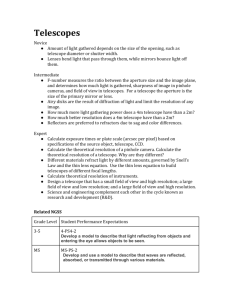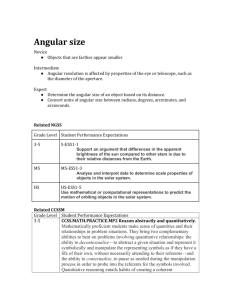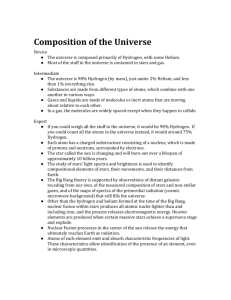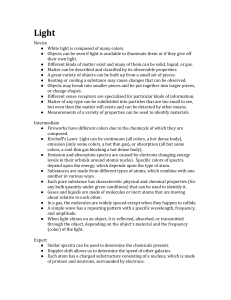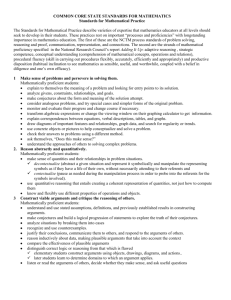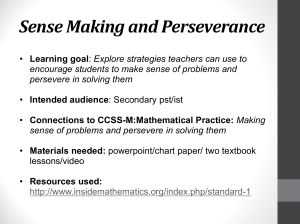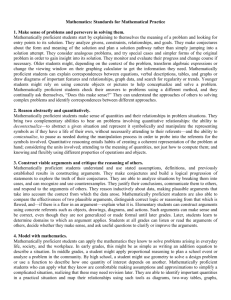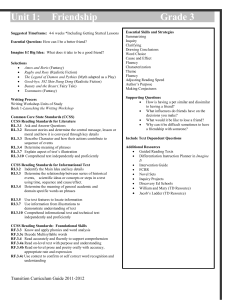Engineering design process
advertisement
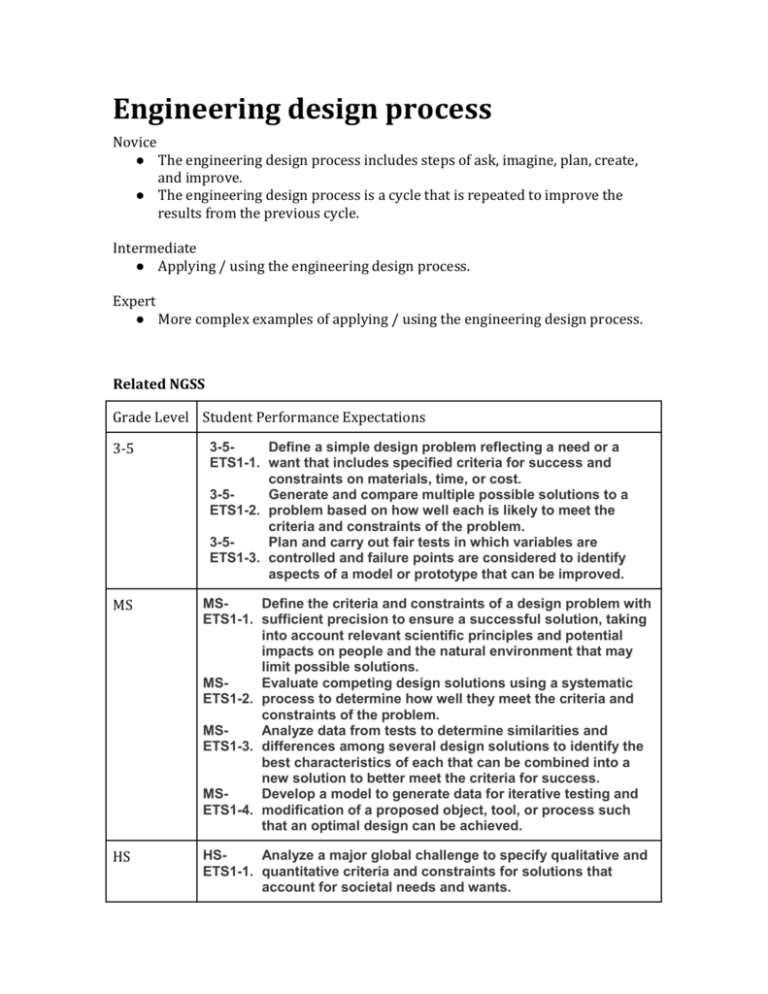
Engineering design process Novice ● The engineering design process includes steps of ask, imagine, plan, create, and improve. ● The engineering design process is a cycle that is repeated to improve the results from the previous cycle. Intermediate ● Applying / using the engineering design process. Expert ● More complex examples of applying / using the engineering design process. Related NGSS Grade Level Student Performance Expectations 3-5 3-5Define a simple design problem reflecting a need or a ETS1-1. want that includes specified criteria for success and constraints on materials, time, or cost. 3-5Generate and compare multiple possible solutions to a ETS1-2. problem based on how well each is likely to meet the criteria and constraints of the problem. 3-5Plan and carry out fair tests in which variables are ETS1-3. controlled and failure points are considered to identify aspects of a model or prototype that can be improved. MS MSDefine the criteria and constraints of a design problem with ETS1-1. sufficient precision to ensure a successful solution, taking into account relevant scientific principles and potential impacts on people and the natural environment that may limit possible solutions. MSEvaluate competing design solutions using a systematic ETS1-2. process to determine how well they meet the criteria and constraints of the problem. MSAnalyze data from tests to determine similarities and ETS1-3. differences among several design solutions to identify the best characteristics of each that can be combined into a new solution to better meet the criteria for success. MSDevelop a model to generate data for iterative testing and ETS1-4. modification of a proposed object, tool, or process such that an optimal design can be achieved. HS HSAnalyze a major global challenge to specify qualitative and ETS1-1. quantitative criteria and constraints for solutions that account for societal needs and wants. HSDesign a solution to a complex real-world problem by ETS1-2. breaking it down into smaller, more manageable problems that can be solved through engineering. HSEvaluate a solution to a complex real-world problem based ETS1-3. on prioritized criteria and trade-offs that account for a range of constraints, including cost, safety, reliability, and aesthetics as well as possible social, cultural, and environmental impacts. HSUse a computer simulation to model the impact of ETS1-4. proposed solutions to a complex real-world problem with numerous criteria and constraints on interactions within and between systems relevant to the problem. Related CCSSM Grade Level 3-5 Student Performance Expectations CCSS.MATH.PRACTICE.MP2 Reason abstractly and quantitatively. Mathematically proficient students make sense of quantities and their relationships in problem situations. They bring two complementary abilities to bear on problems involving quantitative relationships: the ability to decontextualize—to abstract a given situation and represent it symbolically and manipulate the representing symbols as if they have a life of their own, without necessarily attending to their referents—and the ability to contextualize, to pause as needed during the manipulation process in order to probe into the referents for the symbols involved. Quantitative reasoning entails habits of creating a coherent representation of the problem at hand; considering the units involved; attending to the meaning of quantities, not just how to compute them; and knowing and flexibly using different properties of operations and objects. CCSS.MATH.PRACTICE.MP4 Model with mathematics. Mathematically proficient students can apply the mathematics they know to solve problems arising in everyday life, society, and the workplace. In early grades, this might be as simple as writing an addition equation to describe a situation. In middle grades, a student might apply proportional reasoning to plan a school event or analyze a problem in the community. By high school, a student might use geometry to solve a design problem or use a function to describe how one quantity of interest depends on another. Mathematically proficient students who can apply what they know are comfortable making assumptions and approximations to simplify a complicated situation, realizing that these may need revision later. They are able to identify important quantities in a practical situation and map their relationships using such tools as diagrams, two-way tables, graphs, flowcharts and formulas. They can analyze those relationships mathematically to draw MS conclusions. They routinely interpret their mathematical results in the context of the situation and reflect on whether the results make sense, possibly improving the model if it has not served its purpose. CCSS.MATH.PRACTICE.MP5 Mathematically proficient students consider the available tools when solving a mathematical problem. These tools might include pencil and paper, concrete models, a ruler, a protractor, a calculator, a spreadsheet, a computer algebra system, a statistical package, or dynamic geometry software. Proficient students are sufficiently familiar with tools appropriate for their grade or course to make sound decisions about when each of these tools might be helpful, recognizing both the insight to be gained and their limitations. For example, mathematically proficient high school students analyze graphs of functions and solutions generated using a graphing calculator. They detect possible errors by strategically using estimation and other mathematical knowledge. When making mathematical models, they know that technology can enable them to visualize the results of varying assumptions, explore consequences, and compare predictions with data. Mathematically proficient students at various grade levels are able to identify relevant external mathematical resources, such as digital content located on a website, and use them to pose or solve problems. They are able to use technological tools to explore and deepen their understanding of concepts. CCSS.MATH.CONTENT.3.OA.A.1 – CCSS.MATH.CONTENT.5.OA.B.3 Operations and Algebraic Thinking CCSS.MATH.PRACTICE.MP2 Reason abstractly and quantitatively. Mathematically proficient students make sense of quantities and their relationships in problem situations. They bring two complementary abilities to bear on problems involving quantitative relationships: the ability to decontextualize—to abstract a given situation and represent it symbolically and manipulate the representing symbols as if they have a life of their own, without necessarily attending to their referents—and the ability to contextualize, to pause as needed during the manipulation process in order to probe into the referents for the symbols involved. Quantitative reasoning entails habits of creating a coherent representation of the problem at hand; considering the units involved; attending to the meaning of quantities, not just how to compute them; and knowing and flexibly using different properties of operations and objects. CCSS.MATH.CONTENT.7.EE.B.3 Solve multi-step real-life and mathematical problems posed with positive and negative rational numbers in any form (whole numbers, fractions, and decimals), using tools strategically. Apply properties of operations to calculate with numbers in any form; convert between HS forms as appropriate; and assess the reasonableness of answers using mental computation and estimation strategies. CCSS.MATH.CONTENT.7.SP.C.7 Develop a probability model and use it to find probabilities of events. Compare probabilities from a model to observed frequencies; if the agreement is not good, explain possible sources of the discrepancy. CCSS.MATH.PRACTICE.MP2 Reason abstractly and quantitatively. Mathematically proficient students make sense of quantities and their relationships in problem situations. They bring two complementary abilities to bear on problems involving quantitative relationships: the ability to decontextualize—to abstract a given situation and represent it symbolically and manipulate the representing symbols as if they have a life of their own, without necessarily attending to their referents—and the ability to contextualize, to pause as needed during the manipulation process in order to probe into the referents for the symbols involved. Quantitative reasoning entails habits of creating a coherent representation of the problem at hand; considering the units involved; attending to the meaning of quantities, not just how to compute them; and knowing and flexibly using different properties of operations and objects. CCSS.MATH.PRACTICE.MP4 Model with mathematics. Mathematically proficient students can apply the mathematics they know to solve problems arising in everyday life, society, and the workplace. In early grades, this might be as simple as writing an addition equation to describe a situation. In middle grades, a student might apply proportional reasoning to plan a school event or analyze a problem in the community. By high school, a student might use geometry to solve a design problem or use a function to describe how one quantity of interest depends on another. Mathematically proficient students who can apply what they know are comfortable making assumptions and approximations to simplify a complicated situation, realizing that these may need revision later. They are able to identify important quantities in a practical situation and map their relationships using such tools as diagrams, two-way tables, graphs, flowcharts and formulas. They can analyze those relationships mathematically to draw conclusions. They routinely interpret their mathematical results in the context of the situation and reflect on whether the results make sense, possibly improving the model if it has not served its purpose. Relate the domain of a function to its graph and, where applicable, to the quantitative relationship it describes. CCSS.MATH.CONTENT.HSS.ID.B.6 Represent data on two quantitative variables on a scatter plot, and describe how the variables are related.
